Gardening: Sprucing up your yard (Part II)
If your yard is relatively small, you may want to consider one of the smaller varieties of spruce trees.

Reviews and recommendations are unbiased and products are independently selected. Postmedia may earn an affiliate commission from purchases made through links on this page.
Article content
Last week, some of the smaller varieties of Colorado spruce (Picea pungens) such as Bakeri, Fat Albert, Glauca Globosa, Glauca Pendula, Hoopsii, and Montgomery were discussed. All of these take up less space and are better adapted to our smaller landscapes. Similarly, Norway spruce and white spruce are themselves less suited to urban settings but have smaller varieties that work well.
The genus name, Picea, is from the Latin word for pitch pine, which is derived from pix, meaning pitch or resin, which has had many traditional uses. The word spruce was used in the 1660s to denote an evergreen tree from Prussia. It was originally a generic term for commodities brought to England by Hanseatic merchants (especially beer, boards and wooden chests, and leather). Spruce trees were thus believed to be particular to Prussia, which for a time was viewed by the English as a land of luxuries. Thus, its other meaning: “to make trim or neat” or to be “neat, smart in dress and appearance, dapper or brisk,” which appeared as early as the 1590s.
Norway spruce (Picea abies), from central and northern Europe, has a wide distribution and a number of distinct forms. The species forms a large, broadly pyramidal tree with horizontal branches which are sometimes bowed downward with upturned tips, but with a somewhat weeping appearance. The bark is reddish brown. Once widely planted on the prairies, the species is seldom offered today, possibly because of its large size (30 metres). However, smaller forms are readily available.
Nest spruce (P. abies Nidiformis), a dwarf form of Norway spruce, is dense and globe shaped with a flat top. Extremely eye-catching and ornamental, it is slow growing and long lived. It has a height and spread of only 1m by 1.5m at maturity with bright green, sharply pointed needles.
Ohlendorfii Norway spruce (P. abies Ohlendorfii) is another excellent smaller form. If nest spruce has a symmetry about it, Ohlendorfii is the awkward, lumpy cousin with a delightful free-form growth habit when young. It eventually grows to a dense, pyramidal, upright shrub of 2.4m with bright green, sharply pointed needles.
Dwarf Norway spruce (P. abies Pumila) is globe-shaped, dwarf and slow growing with dark green needles and a mature size of .9m by 1.2m.
Little Gem is slow growing, flat-topped with a symmetrical globe form. With a height of only 45 centimetres and a spread of 1.5m, it is an excellent rock garden plant.
Plant these dwarf forms of Norway spruce in full sun to partial shade on well-drained soil. They are very drought tolerant once established and are excellent in a mixed border, rock garden, shrub border or for foundation plantings.
White spruce (Picea glauca) is native to Canada’s boreal forest. They are pyramidal in shape with nearly horizontal branches with dull dark green to bluish green needles that are pointed but not sharp.
Although the species is seldom used, one of its selections, Black Hills spruce (P. glauca var. densata), works well in our landscapes. It was introduced by the Black Hills Nursery of South Dakota in 1920, has a very dependable track record and is better adapted to prairie conditions than the species. A denser and more compact form of white spruce, it has short, dark green needles and a narrow pyramidal form. It makes rapid growth while young, and reaches an ultimate height and spread of 12m by 4.5m, providing food and cover for birds. It should be more widely available.
Black Hills spruce is best planted in full sun and is adaptable to a range of soils. It is resistant to winter desiccation and very drought tolerant. Use it as a specimen tree or in a grouping, as screen plantings and in shelterbelts. It provides food and cover for birds.
A final word on what not to purchase, as written by a colleague, Brian Baldwin, more than a decade ago:
“Dwarf Alberta spruce (Picea glauca var. albertiana Conica) have inescapable charm which makes them a sure sell. Unfortunately, on the prairies, they are also a near certain failure. The very fine needles lack an adequate waxy cuticle to withstand dehydration during dry prairie winters, so specimens exposed to winter wind or sun invariably dry and die. Those that aren’t killed outright are usually so grossly disfigured that they are eventually removed.”
Retired from the University of Saskatchewan, Sara’s most recent book is Growing Fruit in Northern Gardens with Bob Bors. She’s been hosting garden tours for over 20 years — to Great Britain, Ireland, Europe, Turkey and Iceland. Join her for a tour of French gardens this September (Contact Ruth at 1-888-778-2378, www.worldwideecotours.com).
This column is provided courtesy of the Saskatchewan Perennial Society, which can be contacted by email at saskperennial@hotmail.com. Check our website (www.saskperennial.ca) or Facebook page (www.facebook.com/saskperennial) for a list of upcoming gardening events.
The news seems to be flying at us faster all the time. From COVID-19 updates to politics and crime and everything in between, it can be hard to keep up. With that in mind, the Saskatoon StarPhoenix has created an Afternoon Headlines newsletter that can be delivered daily to your inbox to help make sure you are up to date with the most vital news of the day. Click here to subscribe.






Postmedia is committed to maintaining a lively but civil forum for discussion. Please keep comments relevant and respectful. Comments may take up to an hour to appear on the site. You will receive an email if there is a reply to your comment, an update to a thread you follow or if a user you follow comments. Visit our Community Guidelines for more information.